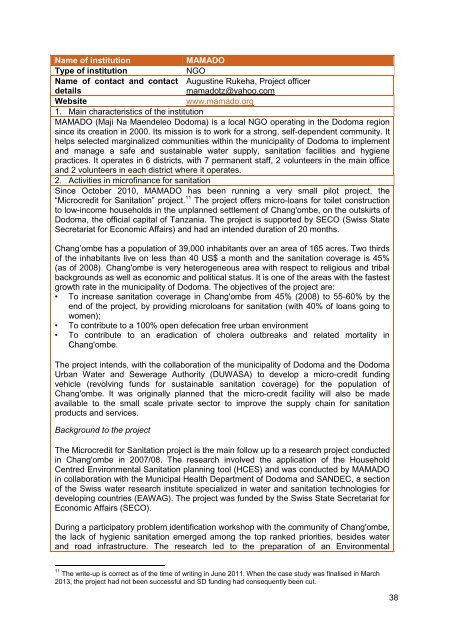REPORT__Evaluating_the_potential_of_microfinance_for_sanitation_in_Tanzania_May_2013
REPORT__Evaluating_the_potential_of_microfinance_for_sanitation_in_Tanzania_May_2013
REPORT__Evaluating_the_potential_of_microfinance_for_sanitation_in_Tanzania_May_2013
Create successful ePaper yourself
Turn your PDF publications into a flip-book with our unique Google optimized e-Paper software.
Name <strong>of</strong> <strong>in</strong>stitution MAMADO<br />
Type <strong>of</strong> <strong>in</strong>stitution NGO<br />
Name <strong>of</strong> contact and contact August<strong>in</strong>e Rukeha, Project <strong>of</strong>ficer<br />
details<br />
mamadotz@yahoo.com<br />
Website www.mamado.org<br />
1. Ma<strong>in</strong> characteristics <strong>of</strong> <strong>the</strong> <strong>in</strong>stitution<br />
MAMADO (Maji Na Maendeleo Dodoma) is a local NGO operat<strong>in</strong>g <strong>in</strong> <strong>the</strong> Dodoma region<br />
s<strong>in</strong>ce its creation <strong>in</strong> 2000. Its mission is to work <strong>for</strong> a strong, self-dependent community. It<br />
helps selected marg<strong>in</strong>alized communities with<strong>in</strong> <strong>the</strong> municipality <strong>of</strong> Dodoma to implement<br />
and manage a safe and susta<strong>in</strong>able water supply, <strong>sanitation</strong> facilities and hygiene<br />
practices. It operates <strong>in</strong> 6 districts, with 7 permanent staff, 2 volunteers <strong>in</strong> <strong>the</strong> ma<strong>in</strong> <strong>of</strong>fice<br />
and 2 volunteers <strong>in</strong> each district where it operates.<br />
2. Activities <strong>in</strong> micr<strong>of</strong><strong>in</strong>ance <strong>for</strong> <strong>sanitation</strong><br />
S<strong>in</strong>ce October 2010, MAMADO has been runn<strong>in</strong>g a very small pilot project, <strong>the</strong><br />
“Microcredit <strong>for</strong> Sanitation” project. 11 The project <strong>of</strong>fers micro-loans <strong>for</strong> toilet construction<br />
to low-<strong>in</strong>come households <strong>in</strong> <strong>the</strong> unplanned settlement <strong>of</strong> Chang'ombe, on <strong>the</strong> outskirts <strong>of</strong><br />
Dodoma, <strong>the</strong> <strong>of</strong>ficial capital <strong>of</strong> <strong>Tanzania</strong>. The project is supported by SECO (Swiss State<br />
Secretariat <strong>for</strong> Economic Affairs) and had an <strong>in</strong>tended duration <strong>of</strong> 20 months.<br />
Chang’ombe has a population <strong>of</strong> 39,000 <strong>in</strong>habitants over an area <strong>of</strong> 165 acres. Two thirds<br />
<strong>of</strong> <strong>the</strong> <strong>in</strong>habitants live on less than 40 US$ a month and <strong>the</strong> <strong>sanitation</strong> coverage is 45%<br />
(as <strong>of</strong> 2008). Chang'ombe is very heterogeneous area with respect to religious and tribal<br />
backgrounds as well as economic and political status. It is one <strong>of</strong> <strong>the</strong> areas with <strong>the</strong> fastest<br />
growth rate <strong>in</strong> <strong>the</strong> municipality <strong>of</strong> Dodoma. The objectives <strong>of</strong> <strong>the</strong> project are:<br />
• To <strong>in</strong>crease <strong>sanitation</strong> coverage <strong>in</strong> Chang'ombe from 45% (2008) to 55-60% by <strong>the</strong><br />
end <strong>of</strong> <strong>the</strong> project, by provid<strong>in</strong>g microloans <strong>for</strong> <strong>sanitation</strong> (with 40% <strong>of</strong> loans go<strong>in</strong>g to<br />
women);<br />
• To contribute to a 100% open defecation free urban environment<br />
• To contribute to an eradication <strong>of</strong> cholera outbreaks and related mortality <strong>in</strong><br />
Chang'ombe.<br />
The project <strong>in</strong>tends, with <strong>the</strong> collaboration <strong>of</strong> <strong>the</strong> municipality <strong>of</strong> Dodoma and <strong>the</strong> Dodoma<br />
Urban Water and Sewerage Authority (DUWASA) to develop a micro-credit fund<strong>in</strong>g<br />
vehicle (revolv<strong>in</strong>g funds <strong>for</strong> susta<strong>in</strong>able <strong>sanitation</strong> coverage) <strong>for</strong> <strong>the</strong> population <strong>of</strong><br />
Chang'ombe. It was orig<strong>in</strong>ally planned that <strong>the</strong> micro-credit facility will also be made<br />
available to <strong>the</strong> small scale private sector to improve <strong>the</strong> supply cha<strong>in</strong> <strong>for</strong> <strong>sanitation</strong><br />
products and services.<br />
Background to <strong>the</strong> project<br />
The Microcredit <strong>for</strong> Sanitation project is <strong>the</strong> ma<strong>in</strong> follow up to a research project conducted<br />
<strong>in</strong> Chang'ombe <strong>in</strong> 2007/08. The research <strong>in</strong>volved <strong>the</strong> application <strong>of</strong> <strong>the</strong> Household<br />
Centred Environmental Sanitation plann<strong>in</strong>g tool (HCES) and was conducted by MAMADO<br />
<strong>in</strong> collaboration with <strong>the</strong> Municipal Health Department <strong>of</strong> Dodoma and SANDEC, a section<br />
<strong>of</strong> <strong>the</strong> Swiss water research <strong>in</strong>stitute specialized <strong>in</strong> water and <strong>sanitation</strong> technologies <strong>for</strong><br />
develop<strong>in</strong>g countries (EAWAG). The project was funded by <strong>the</strong> Swiss State Secretariat <strong>for</strong><br />
Economic Affairs (SECO).<br />
Dur<strong>in</strong>g a participatory problem identification workshop with <strong>the</strong> community <strong>of</strong> Chang'ombe,<br />
<strong>the</strong> lack <strong>of</strong> hygienic <strong>sanitation</strong> emerged among <strong>the</strong> top ranked priorities, besides water<br />
and road <strong>in</strong>frastructure. The research led to <strong>the</strong> preparation <strong>of</strong> an Environmental<br />
11 The write-up is correct as <strong>of</strong> <strong>the</strong> time <strong>of</strong> writ<strong>in</strong>g <strong>in</strong> June 2011. When <strong>the</strong> case study was f<strong>in</strong>alised <strong>in</strong> March<br />
<strong>2013</strong>, <strong>the</strong> project had not been successful and SD fund<strong>in</strong>g had consequently been cut.<br />
38


